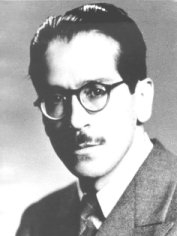Hernán Siles Zuazo
| Hernán Siles | |
|---|---|
 |
|
| 51st, 54th, and 71st President of Bolivia | |
|
In office 10 October 1982 – 6 August 1985 |
|
| Vice President | Jaime Paz Zamora (1982-1984) |
| Preceded by | Guido Vildoso |
| Succeeded by | Víctor Paz Estenssoro |
|
In office 6 August 1956 – 6 August 1960 |
|
| Vice President | Ñuflo Chávez Ortiz (1956-1957) |
| Preceded by | Víctor Paz Estenssoro |
| Succeeded by | Víctor Paz Estenssoro |
|
In office 11 April 1952 – 16 April 1952 |
|
| Preceded by | Hugo Ballivián |
| Succeeded by | Víctor Paz Estenssoro |
| Vice President of Bolivia | |
|
In office 16 April 1952 – 6 August 1956 |
|
| President | Víctor Paz Estenssoro |
| Preceded by | Mamerto Urriolagoitía |
| Succeeded by | Ñuflo Chávez Ortiz |
| Personal details | |
| Born |
Hernán Siles Zuazo 21 March 1914 La Paz, Bolivia |
| Died | 6 August 1996 (aged 82) Montevideo, Uruguay |
| Nationality | Bolivian |
| Political party |
MNR (1941-1971) MNRI (1971-1985) |
| Spouse(s) | María Teresa Ormachea de Siles |
Hernán Siles Zuazo (21 March 1914 - 6 August 1996) was a Bolivian politician who served as constitutionally elected president twice, from 1956 to 1960 and again from 1982 to 1985. He also briefly served as the temporary president in April 1952, and as vice president between 1952 and 1956.
Hernán Siles was the illegitimate son of the last Republican Party president of Bolivia, Hernando Siles and Isabel Zuazo Cusicanqui. Siles was raised by his mother. His half-brother Luis Adolfo Siles Salinas was President for five months in 1969.
In 1931 Siles graduated from the American Institute in La Paz. He served in Bolivian army and was decorated for injury sustained while fighting in the Chaco War of 1932-35. After the war he finished San Andres University with a degree in law.
Siles was married to Maria Teresa Ormachea del Carpio and had three daughters, Marcela, Ana Maria and Isabel.
In 1940 Siles was elected in the Chamber of Deputies. Gravitating toward the reformist side of the political spectrum (even though his father had been one of the pillars of the Old Regime), in 1941 he founded along with Víctor Paz Estenssoro and others, the influential Revolutionary Nationalist Movement (Movimiento Nacionalista Revolucionario, or MNR).
The MNR was behind the coup that installed the progressive military administration of Gualberto Villarroel (1943–46), but was forced from power due to U.S. pressure and also by Villarroel's overthrow in 1946 after which Siles was exiled to Argentina. There he worked as a correspondent for Associated Press from November 1947 until September 1948.
In the 1951 elections Paz Estenssoro run for presidency with Siles as his vice-presidential running mate, and won the contest with 42.9% of the vote. However, the ultra-conservative government of Mamerto Urriolagoitía refused to recognize the results and instead turned over the presidency to the commander of the Bolivian army, general Hugo Ballivián. At that point the MNR party went underground and in April 9–11, 1952 led the historic Bolivian National Revolution, aided by defections from the armed forces to the rebel cause (key among which was general Antonio Seleme). Siles played a major role in the revolutionary uprising, along with Juan Lechín, since the MNR leader Paz Estenssoro was at the time in exile in Argentina.
...
Wikipedia
